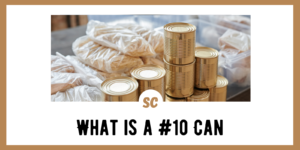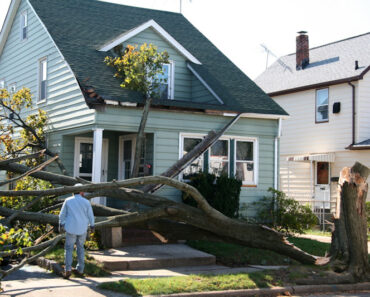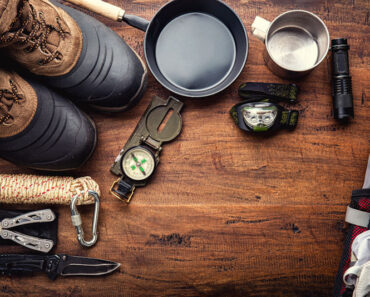For anyone planning on food storage for a bug-out location or simply stocking up the home pantry, #10 cans are relatively common to find supplies in. Not only can you get many freeze-dried and ready-to-eat foods in easy-to-store #10 cans, but a #10 can of food has an incredible number of servings, making them highly economical when planning long-term storage or storage for larger families or groups.
There are some things about #10 cans that some folks don’t realize, however, so before you take the leap and fill the trunk or truck bed with new cans, read on. There are significant benefits, but there are also undeniable drawbacks to most #10 cans, so learn all you can before you decide if #10 cans are right for your survival needs.
What Is A #10 Can?
A #10 can, sometimes called a ten-pound can or a number ten can, is a standardized size of can used to store food. You can find #10 cans used in many different scenarios, both at cost-cutting large warehouse stores like Sam’s or Costco, as the primary size of canned supplies sold at restaurant suppliers, and as the default size for many survival goods.
How Large Are #10 Cans?
The size #10 cans are standardized both in height and diameter. A number 10 can will be 7 inches by 6 3/16 inches and will have a tare weight, or the weight of the empty container itself, of about 9 ounces. A #10 can’s volume will be able to hold more than 100 ounces depending on what is being held in the can, and can reach total weights of between 109 and 117 ounces.
This means they can store nearly a full gallon of water or other liquids, but they will have significant weight to them. The rigid metal of the container walls and the cylindrical shape give them a very high crush resistance, and they can be stacked in very large numbers.
What Can Be Stored In #10 Cans?
The total weight and the overall amount of food that you can store in a #10 can will fluctuate depending on what you’re storing in it. Here is a quick list of some common items you may want to consider storing in #10 cans:
- Pre-cooked stock
- Cooked vegetables
- Salt
- Rice
- Powdered milk
- Powdered eggs
- Whole oats
- Freeze-dried meat
- Freeze-dried fruit
Keep in mind that no matter what you store in #10 cans, the amount you can comfortably store in the can will depend on what it is, the variety, and how it has been prepared for storage. Cooked or ready-to-eat items will often have much more water in them, making them far heavier than dried or freeze dried options.
Why #10 Cans For Food Storage Are An Ideal Solution
One of the biggest benefits to #10 cans lie in their construction and design. We mentioned earlier that the cylindrical design lends to a very simple and strong stacking ability, but the construction of the cans is important as well, particularly for those looking to store things long-term.
#10 cans are made from a type of tin-coated steel, often plated through an electroplating process, which results in a very even and secure deposition of the particulate tin. This results in a very safe, non-toxic, and high corrosion-resistance can, that is also usually coated on the inside as well, to guard the food taste and quality. These acrylic or enamel coatings create a barrier between the food and the storage medium, giving them an incredible shelf life.
What Is Ideally Stored In Consumer-Grade #10 Cans?
This is where things may start to get a little disappointing for some, but it may also help simplify some of your potential storage needs. If you have a supply of #10 cans and are trying to find out what you can store in them, the good news is that you can store just about any dry goods you can think of in them, even valuables like ammo. If you have large amounts of dry beans, grain, rice, or flour, #10 cans might be your best option for strong, practical long-term storage.
However, they are reportedly not ideal for wet goods like soups, stews, broths, or potable water. The #10 cans that you will buy from retailers have been commercially canned and sealed, which is a far more extensive process that you’ll likely be able to do at your home. For this reason alone, most #10 cans that are made for home canning will not be lined, meaning they will be susceptible to corrosion over time if wet goods are stored in them.
What Are The Pros & Cons To #10 Cans?
Here are the ups and downs of working with #10 cans, no matter what the eventual applications may be.
The Good News
The pros of using #10 cans are nothing to ignore, and can easily be a viable storage solution for many things. Firstly, they are air, light, and moisture-tight, so no matter what you put in them, you will be able to safely store them for many years. Secondly, they have an amazing ability to withstand incredible storage and disaster conditions, with many #10 cans being used during hurricane survival without being damaged or breached.
The Drawbacks Of #10 Cans
There are some downsides to potentially using #10 cans for your emergency food storage. First off, if you are storing wet items, you will see a dramatic reduction in the long-term corrosion resistance. Secondly, to even get the ability to seal the cans at home you’ll need a can sealer which can start out around $500 for a basic manual sealer. Additionally, the empty cans that can be sealed at home are generally not cheap, and will run several dollars per can, often offsetting any savings obtained by storing.
If you do decide to use #10 cans for home canning, you will also need to remember that once you open a can, the clock’s ticking on the freshness, so you’ll need to be able to finish the contents in a reasonable amount of time to prevent waste. Lastly, they are bulky and heavy, particularly when you have several dozen or even several hundred that eventually require their own storage space with reinforced shelving.
Wrapping Up
If you are considering long-term storage of dry goods with a very low weight, #10 cans may just be perfect for you. If you’re looking for a way to store pre-made wet goods like soups, broths, and more, then you may want to look into alternatives that are more cost-effective and corrosion-resistant over long periods. Otherwise, #10 cans are a great way to get a strong, stackable storage solution for your dry goods.




























